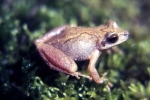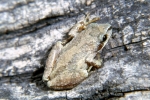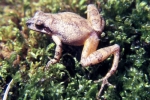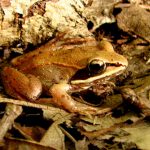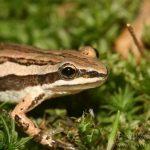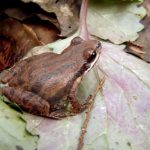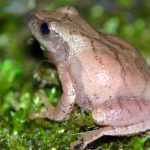Mountain Chorus Frog

Scientific Name: Pseudacris brachyphona
Size: 1.6-2 inches (4-5 cm) in length
Status: Species of special concern
Habitat:
Deciduous woodlands and upland wood areas. This species is not associated with water.
Description:
A small species. The background color ranges from tan to light brown with a dark brown to black markings that are variably shaped but commonly resembles the look of inverted parentheses that extends from the back of the head to the groin along the sides of the body. The head typically has a triangular blotch or pattern located between the eyes, but this may not be apparent on all individuals. The underside is cream-colored with a stippled pattern.
- The dorsal background color ranges from tan to light brown with a dark brown to black markings that are variably shaped but commonly resembles the look of inverted parentheses that extends from the back of the head to the groin; along the sides of the body.
- The head typically has a triangular blotch or pattern located between the eyes, but this may not be apparent on all individuals.
- The ventral is cream-colored with a stippled pattern
- Small species.
- The body is robust.
- The head is broad and flat with a blunt snout.
- The eyes are large and positioned on the sides of the head.
- The dorsal skin slightly rough.
- The ventral skin is coarsely granular.
- The fore legs are small and thin.
- The hind legs are long and slender.
- The toes have minimal webbing.
- The toe tips have small well-developed disc.
- Small-sized. Average 1-3 cm
- The dorsum and sides are dark brown and may have a metallic/bronze flecking.
- The belly is bronze and iridescent.
- The tail crest is moderately developed and translucent, with small dark spots and fleaks.


May be Confused With:
References:
- Hulse, C. and McCoy C. J. and Ellen Censky ,1998. Amphibians and Reptiles of Pennsylvania and the Northeast. 148-151pp.
- Tom Diez
- Dylan Cooper
- Jason Poston
Heads up!
Please contribute your observation of this and other herps to the Pennsylvania Amphibian and Reptile Survey. Your help is needed.
